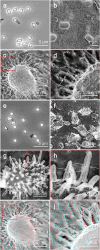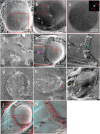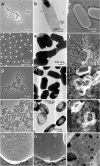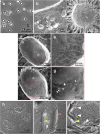Visualization of Bacillus subtilis spore structure and germination using quick-freeze deep-etch electron microscopy
- PMID: 38819330
- PMCID: PMC11630275
- DOI: 10.1093/jmicro/dfae023
Visualization of Bacillus subtilis spore structure and germination using quick-freeze deep-etch electron microscopy
Abstract
Bacterial spores, known for their complex and resilient structures, have been the focus of visualization using various methodologies. In this study, we applied quick-freeze and replica electron microscopy techniques, allowing observation of Bacillus subtilis spores in high-contrast and three-dimensional detail. This method facilitated visualization of the spore structure with enhanced resolution and provided new insights into the spores and their germination processes. We identified and described five distinct structures: (i) hair-like structures on the spore surface, (ii) spike formation on the surface of lysozyme-treated spores, (iii) the fractured appearance of the spore cortex during germination, (iv) potential connections between small vesicles and the core membrane and (v) the evolving surface structure of nascent vegetative cells during germination.
Keywords: bacteria; cortex; dormant; hairy structure; peptidoglycan; rodlet layer.
© The Author(s) 2024. Published by Oxford University Press on behalf of The Japanese Society of Microscopy.
Figures






Similar articles
-
Morphological Changes in Spores during Germination in Bacillus cereus and Bacillus subtilis.Biocontrol Sci. 2020;25(4):203-213. doi: 10.4265/bio.25.203. Biocontrol Sci. 2020. PMID: 33281178
-
Muramic lactam in peptidoglycan of Bacillus subtilis spores is required for spore outgrowth but not for spore dehydration or heat resistance.Proc Natl Acad Sci U S A. 1996 Dec 24;93(26):15405-10. doi: 10.1073/pnas.93.26.15405. Proc Natl Acad Sci U S A. 1996. PMID: 8986824 Free PMC article.
-
Germination, Outgrowth, and Vegetative-Growth Kinetics of Dry-Heat-Treated Individual Spores of Bacillus Species.Appl Environ Microbiol. 2018 Mar 19;84(7):e02618-17. doi: 10.1128/AEM.02618-17. Print 2018 Apr 1. Appl Environ Microbiol. 2018. PMID: 29330188 Free PMC article.
-
The role of peptidoglycan structure and structural dynamics during endospore dormancy and germination.Antonie Van Leeuwenhoek. 1999 May;75(4):299-307. doi: 10.1023/a:1001800507443. Antonie Van Leeuwenhoek. 1999. PMID: 10510717 Review.
-
Germination of spores of Bacillus species: what we know and do not know.J Bacteriol. 2014 Apr;196(7):1297-305. doi: 10.1128/JB.01455-13. Epub 2014 Jan 31. J Bacteriol. 2014. PMID: 24488313 Free PMC article. Review.
Cited by
-
Combination of fluorescent reagents with 2-(4-aminophenyl) benzothiazole and safranin O was useful for analysis of spore structure, indicating the diversity of Bacillales species spores.Front Microbiol. 2025 Jun 25;16:1603957. doi: 10.3389/fmicb.2025.1603957. eCollection 2025. Front Microbiol. 2025. PMID: 40636494 Free PMC article.
References
MeSH terms
Grants and funding
LinkOut - more resources
Full Text Sources

